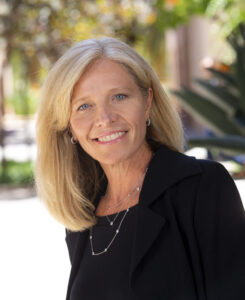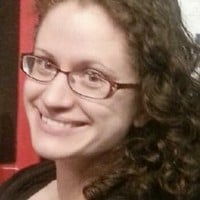In our latest Admissions Director Q&A, we interview Kirsten Moss, Assistant Dean of MBA Admissions & Financial Aid at Stanford GSB. She digs into everything you need to know about the leading business school, including what makes a strong application, what to expect in the interview and more.

Prior to Stanford GSB, Kirsten held roles in leadership coaching, consulting, admissions and more. In addition to being an executive coach for senior executives in various sectors, she had worked as a consultant for Egon Zehnder, developing tools to assess leadership potential. Earlier in her career, she was the Director of Career Services and the Director of Admissions and Financial Aid at Harvard Business School. Kirsten has an AB in economics, government, and sociology from Harvard College and an MBA from Harvard Business School. She has a Doctorate of Psychology from William James College where her research examined how to assess transformational leadership during selection interviews.
Read on for her insights into the Stanford GSB MBA experience, admissions, interview and much more.
Clear Admit: What is the one aspect of your program that you wish applicants knew more about?
Kirsten Moss: There is so much to take advantage of within the Stanford Graduate School of Business. But one aspect that applicants might not be as aware of is how much we encourage you to explore all that Stanford University has to offer. Your interests and goals may span multiple academic disciplines or areas of expertise. That is why the Stanford MBA Program empowers you to combine studies. This flexibility offers a rich and valuable academic experience. Generally, about 20 percent of Stanford MBA students take advantage of a joint or dual degree to complement their MBA. As a student, you may also take courses in any department or graduate school at Stanford University. About 85% of our MBA students take classes at one of Stanford’s other world-class schools, including Education, Engineering, Humanities & Sciences, Law, Medicine, and our new School of Sustainability.
CA: Walk us through the life of an application in your office from an operational standpoint. What happens between the time an applicant clicks “submit” and the time the committee offers a final decision?
KM: After the application deadline, our admissions officers begin reviewing them holistically. The candidates we identify as the strongest prospective students for our program are invited to interview. Once the interview is complete, the interviewer provides an assessment, which the Admissions Committee considers in combination with the written application. On the day of the relevant deadline, the Admissions Office posts the committee’s admission decision.
CA: How does your team approach the essay portion of the application specifically? What are you looking for as you read an essay? Are there common mistakes that applicants should try to avoid? What is one key thing they should keep in mind as they sit down to write?
KM: We have two required essays. The first asks, “What matters most and why?” In this essay, we seek to learn about your values and what motivates you. The second asks, “Why Stanford? Describe your aspirations and how your Stanford GSB experience will help you realize them.” In this essay, we try to understand what you hope to do. We also pay attention to what is most compelling to you about the GSB experience and how our program can help you bridge the gap between where you are now and where you want to go.
In addition to the required essays, we have optional short answer questions where we ask you to think about a time when you have created a positive impact, whether in professional, extracurricular, academic, or other settings. “What was your impact and what made it significant to you or others?” You may share up to three examples with us. We ask this question to give you an opportunity to tell us what you have done that is meaningful to you. We hear about some of your achievements from your recommenders, but they may only know about your contributions in one specific role or organization. We want you to tell us in your own words what makes you most proud.
A strong application helps us understand your values, your aspirations, and your impact. The key thing to keep in mind as you write is to tell us your story, not the one you think we want to hear. I promise you that your story will be far more captivating to us.
CA: Could you tell us about the Stanford GSB interview process? Approximately how many applicants do you interview? Who conducts the interview (students, admissions officers, alumni) and what is the nature of the interview (resume-based, behavioral)?
KM: We interview approximately 2-3 candidates for every seat in the class. Alumni conduct the majority of the interviews, and the interviews last approximately 45 minutes. Alumni interviews also give applicants an opportunity to meet members of our community. The alumni interviewers are provided candidates’ resumes; however, they do not have access to their applications.
Since our interviews are based on past behavior, we focus on understanding your past actions – both what you have done and how you have done it. To prepare for your interview, think about times in the past few years when you have been effective or proud of your efforts. What was the situation? What action did you take? What was the result? Also, come prepared with questions for your interviewer, so you can learn about his or her experience at Stanford GSB.
CA: What is your testing policy? Do you offer exam waivers? Why or why not?
KM: The GMAT or GRE is required for admission to the MBA program, as is TOEFL, PTE or IELTS if applicable. However, due to the COVID-19 pandemic, we are accepting the official online versions of the exams. Tests must be taken before the deadline date of the application round in which you plan to apply. We do not offer exam waivers.
Remember that your test scores are just one piece of your application. We consider your scores within the context of factors such as the resources available to you, the educational systems within your university and country, etc.
CA: Tell us briefly about two popular courses at your institution.
KM: Interpersonal Dynamics has been voted the most popular elective for nearly 50 years at Stanford GSB and is affectionately referred to as “Touchy Feely.” The course delivers a highly personalized learning experience with the ultimate goal of creating more productive, professional relationships. Most of the learning occurs in “T-group” sessions in which small groups of 12 students learn about themselves and the nuances of interpersonal dynamics, aided by Stanford-trained facilitators. You observe how individual behavior affects others in real time, practice key leadership skills with peer feedback, and learn to connect across differences. Through experiential-based activities, you ultimately improve your ability to authentically engage, communicate, and influence.
Another very popular course is Managing Growing Enterprises. The class addresses the unique challenges faced by entrepreneurs as they rapidly scale a company and is taught by entrepreneurial leaders who have successfully navigated the challenges of managing a growing firm. Through case studies and role playing, you learn from a wide variety of class guests about how to handle challenges such as missing revenue forecasts, dealing with employee performance issues, managing challenging board interactions, leading an organization through a publicly visible crisis and negotiating with aggrieved partners. It’s an excellent class for anyone who aspires to manage or own a business.
CA: As we learn to live with COVID-19, campuses have opened up and students are back. What about prospective students? Will they have the opportunity to visit campus? Will admissions interviews be conducted virtually?
KM: In spring 2022 we invited prospective students to campus for some class visits and small group sessions with an admissions officer. Our hope is to expand on campus visit opportunities in the fall. Admission interviews may take place remotely or in person. We continue to monitor the latest health and safety guidance which informs our decisions.
We are very excited to be on the road again, meeting prospective students in person in their local communities. We also offer many types of virtual events to help candidates learn more about Stanford. I would advise students to attend a selection of events customized to their interests. We are hosting panels with specific focus on industry, geography, gender, and diversity. Some panels will feature alumni from different regions around the world. Other panels will focus on alumni with specific career interests such as consulting, finance, technology, and social impact. In addition, we offer smaller discussion forums with admissions officers and with current students. I invite you to visit our website and enroll for in-person or virtual events that will help you understand how Stanford can help you achieve your aspirations.
CA: Is there anything else you’d like to highlight about your MBA program or admissions process?
KM: Do not take yourself out of the running because you believe you do not have the “right” profile. There is no right profile. We are looking for individuals who aspire to change lives, change organizations, and maybe even change the world. If you have ever developed a new insight, taken initiative, persisted through a tough challenge, or invested in the growth of others, tell us. We want to know.









